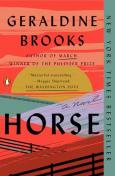BKMT READING GUIDES
Horse: A Novel
by Geraldine Brooks
Paperback : 464 pages
44 clubs reading this now
1 member has read this book
“Horse isn’t just an animal story—it’s a moving narrative about race and art.” —TIME
“A thrilling story about humanity in all its ugliness and beauty . . . the ...
Introduction
“Brooks’ chronological and cross-disciplinary leaps are thrilling.” —The New York Times Book Review
“Horse isn’t just an animal story—it’s a moving narrative about race and art.” —TIME
“A thrilling story about humanity in all its ugliness and beauty . . . the evocative voices create a story so powerful, reading it feels like watching a neck-and-neck horse race, galloping to its conclusion—you just can’t look away.” —Oprah Daily
Winner of the Anisfield-Wolf Book Award, the Dayton Literary Peace Prize, and the Dr. Tony Ryan Book Award · Finalist for the Chautauqua Prize · A Massachusetts Book Award Honor Book
A discarded painting in a junk pile, a skeleton in an attic, and the greatest racehorse in American history: from these strands, a Pulitzer Prize winner braids a sweeping story of spirit, obsession, and injustice across American history
Kentucky, 1850. An enslaved groom named Jarret and a bay foal forge a bond of understanding that will carry the horse to record-setting victories across the South. When the nation erupts in civil war, an itinerant young artist who has made his name on paintings of the racehorse takes up arms for the Union. On a perilous night, he reunites with the stallion and his groom, very far from the glamor of any racetrack.
New York City, 1954. Martha Jackson, a gallery owner celebrated for taking risks on edgy contemporary painters, becomes obsessed with a nineteenth-century equestrian oil painting of mysterious provenance.
Washington, DC, 2019. Jess, a Smithsonian scientist from Australia, and Theo, a Nigerian-American art historian, find themselves unexpectedly connected through their shared interest in the horse—one studying the stallion’s bones for clues to his power and endurance, the other uncovering the lost history of the unsung Black horsemen who were critical to his racing success.
Based on the remarkable true story of the record-breaking thoroughbred Lexington, Horse is a novel of art and science, love and obsession, and our unfinished reckoning with racism.
Editorial Review
No Editorial Review Currently AvailableDiscussion Questions
1. On page 28 (Theo, Georgetown, Washington, DC, 2019), Theo reflects that depictions of horses are among the oldest art humans created. The book’s epigraphs reflect on the significance of Lexington --- in his day, an even bigger celebrity than Seabiscuit or Secretariat. Discuss the enduring human fascination with horses. Do they move you more than other animals? If so, why?2. Theo and Jess are both obsessed with their rarefied fields of expertise. Does the author manage to convey why these unusual careers can be so compelling? If so, how?
3. Jarret’s connection with horses is presented as stronger than his bonds with people. How does his love for and dedication to Lexington help or hamper his coming of age and his transformation over the course of the novel?
4. Horseracing in the mid-19th century was very different to its modern iteration. What surprised you? Do you think horseracing today takes adequate care for the well-being of equines?
5. On p. 71 (Thomas J. Scott, The Meadows, Lexington, Kentucky, 1852), Scott writes, “[We] who think we are above enslaving our fellow man are corrupted. Only show us absolute agency over the apt and the willing, and suddenly we find the planters’ obduracy that much less odious. I must guard against the rank seductions of this place.” How does the author draw out the similarities and differences between Northern and Southern attitudes in this era through Thomas J. Scott, a practiced observer who moves between the regions?
6. Several historical figures appear in the novel, among them the emancipationist newspaper publisher Cassius Clay and his daughter, the suffragist Mary Barr Clay. What are Cassius Clay’s arguments for emancipation to the Warfield family? Do you see the roots of what would become Mary Barr Clay’s passion for the women’s suffrage movement in the way she is portrayed in her youth? What are their respective strengths and limitations? How do novels make historical figures come alive for us beyond what we might find in a work of nonfiction?
7. Martha Jackson was a real American gallery owner and art collector. Discuss her portrayal in HORSE and what her relationship to the painting of Lexington conveys about her character. What does her storyline contribute to the novel’s themes? What did her chapters reveal to you about America in that era, and did you notice any similarities between the art world of the mid-20th century and the horse racing economy of a century prior?
8. Referring to the Civil War on p. 87 (Jess, Smithsonian Museum of Natural History, Washington, DC, 2019), Jess says, “Not my war […] Unless you call Australia the very Deep South.” Theo is also not American. Nevertheless, they’re both forced to reckon with the legacy of slavery --- particularly Theo, who encounters racism in his daily life. How does this affect their relationship? What does the novel reveal about the way history shapes our present moment?
9. Discuss Theo and Jess’ relationship. What do you think attracts them to one another despite their differences? What do they learn from each other?
10. Examine Jess’ conversation with Daniel in the aftermath of what happens to Theo at the end of the novel. What did you make of Daniel’s assessment of the situation? Do you share his point of view?
From readinggroupguides.com
Book Club Recommendations
Recommended to book clubs by 0 of 0 members.
Book Club HQ to over 88,000+ book clubs and ready to welcome yours.
Get free weekly updates on top club picks, book giveaways, author events and more








